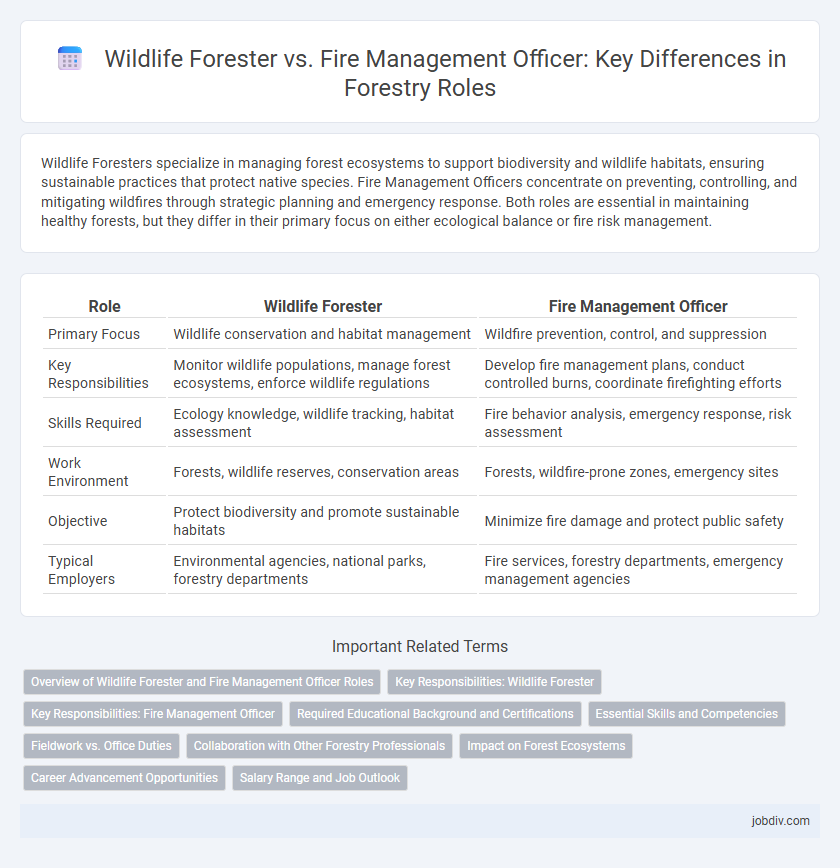Wildlife Foresters specialize in managing forest ecosystems to support biodiversity and wildlife habitats, ensuring sustainable practices that protect native species. Fire Management Officers concentrate on preventing, controlling, and mitigating wildfires through strategic planning and emergency response. Both roles are essential in maintaining healthy forests, but they differ in their primary focus on either ecological balance or fire risk management.
Table of Comparison
| Role | Wildlife Forester | Fire Management Officer |
|---|---|---|
| Primary Focus | Wildlife conservation and habitat management | Wildfire prevention, control, and suppression |
| Key Responsibilities | Monitor wildlife populations, manage forest ecosystems, enforce wildlife regulations | Develop fire management plans, conduct controlled burns, coordinate firefighting efforts |
| Skills Required | Ecology knowledge, wildlife tracking, habitat assessment | Fire behavior analysis, emergency response, risk assessment |
| Work Environment | Forests, wildlife reserves, conservation areas | Forests, wildfire-prone zones, emergency sites |
| Objective | Protect biodiversity and promote sustainable habitats | Minimize fire damage and protect public safety |
| Typical Employers | Environmental agencies, national parks, forestry departments | Fire services, forestry departments, emergency management agencies |
Overview of Wildlife Forester and Fire Management Officer Roles
Wildlife Foresters specialize in managing habitats to support biodiversity, focusing on the conservation of animal species and ecosystems through habitat assessment, restoration, and monitoring. Fire Management Officers concentrate on mitigating wildfire risks by developing fire prevention strategies, coordinating controlled burns, and responding to fire emergencies to protect forest resources and public safety. Both roles require expertise in forest ecology, but Wildlife Foresters emphasize wildlife conservation while Fire Management Officers prioritize fire risk reduction and management.
Key Responsibilities: Wildlife Forester
Wildlife Foresters specialize in managing habitats to support biodiversity, conducting population surveys, and implementing conservation strategies to protect wildlife species. They collaborate with environmental scientists to assess ecosystem health and design sustainable land use plans that balance forestry operations with habitat preservation. Their key responsibilities include monitoring wildlife populations, managing habitats, and enforcing regulations to ensure ecological integrity within forested areas.
Key Responsibilities: Fire Management Officer
Fire Management Officers specialize in developing and implementing fire prevention, detection, and suppression strategies to protect forests and wildlife habitats. Their key responsibilities include coordinating controlled burns, managing wildfire response teams, and conducting risk assessments to minimize fire hazards. They also collaborate with forestry personnel and emergency services to ensure effective wildfire mitigation and ecological restoration.
Required Educational Background and Certifications
Wildlife Foresters typically require a bachelor's degree in wildlife biology, forestry, or environmental science, often complemented by certifications such as the Certified Wildlife Biologist (CWB) credential. Fire Management Officers generally hold degrees in forestry, fire science, or natural resource management, with certifications like the National Wildfire Coordinating Group (NWCG) qualifications essential for fire suppression and management roles. Both positions emphasize specialized training, but Fire Management Officers prioritize fire behavior and incident command system certifications, while Wildlife Foresters focus on ecological and habitat management credentials.
Essential Skills and Competencies
Wildlife Foresters require expertise in habitat assessment, species identification, and ecological monitoring to support biodiversity conservation and sustainable forest management. Fire Management Officers must excel in fire behavior analysis, emergency response coordination, and risk assessment to effectively prevent and control wildfires. Both roles demand strong communication skills, decision-making abilities, and knowledge of forest regulations to ensure environmental protection and public safety.
Fieldwork vs. Office Duties
Wildlife Foresters primarily engage in fieldwork, conducting habitat assessments, tracking animal populations, and implementing conservation strategies in natural environments. Fire Management Officers typically balance office duties such as planning controlled burns and coordinating firefighting resources with on-site supervision during fire events. The distinction lies in the hands-on ecological monitoring by Wildlife Foresters versus the strategic planning and emergency response coordination led by Fire Management Officers.
Collaboration with Other Forestry Professionals
Wildlife Foresters and Fire Management Officers collaborate closely with foresters, ecologists, and conservation biologists to balance habitat preservation and fire risk reduction. Their joint efforts integrate wildlife habitat assessments with fire management plans, ensuring ecosystem sustainability and safety. Effective communication and shared data systems enhance coordinated responses to forest health challenges and wildfire emergencies.
Impact on Forest Ecosystems
Wildlife Foresters play a critical role in preserving biodiversity by managing habitats to support native species and maintain ecological balance in forest ecosystems. Fire Management Officers focus on mitigating the risks and impacts of wildfires through controlled burns and fire suppression strategies, which help protect forest structure and promote regeneration. Both positions contribute significantly to sustaining healthy forest ecosystems, with Wildlife Foresters emphasizing species conservation and Fire Management Officers prioritizing wildfire risk reduction.
Career Advancement Opportunities
Wildlife Foresters specialize in habitat management and species conservation, offering career advancement through roles such as Senior Wildlife Biologist or Conservation Program Manager. Fire Management Officers focus on wildfire prevention and suppression, advancing to positions like Fire Operations Chief or Emergency Management Director. Both careers provide pathways to leadership roles within government agencies, environmental organizations, and private sector forestry firms.
Salary Range and Job Outlook
Wildlife Foresters typically earn between $45,000 and $75,000 annually, with job growth projected at about 5% over the next decade due to increasing conservation efforts. Fire Management Officers have a salary range of approximately $50,000 to $80,000, driven by rising demand for wildfire prevention and response strategies. Employment opportunities for both roles are concentrated in regions with extensive forestland and are influenced by climate change impacts on ecosystems.
Wildlife Forester vs Fire Management Officer Infographic

 jobdiv.com
jobdiv.com